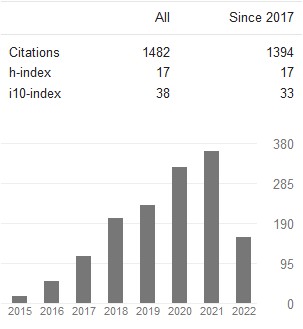Evaluation & formulation of paracetamol matrix sustained release tablets using natural polymers
Abstract
Objectives: To prepare tablets by direct compression method using natural gums such as acacia (F1, F2 and F3), gelatin (F4, F5 and F6) and tragacanth (F7, F8 and F9) at different concentrations. To assess the flow properties of the powder blend (polymers mixed with the drug). To evaluate physical properties of the polymer matrix based tablets for weight variation, hardness, friability, thickness, drug content uniformity, disintegration time, swelling index and in-vitro drug release. To perform stability studies for the optimized formula. Method: In the current investigation, an attempt was done to formulate sustained release matrix tablets using natural polymers, acacia, gelatin and tragacanth as release modifier. Paracetamol was used as a model drug. The different ratios used drug: Lactose: polymer were 100: 200: 50, 100: 150: 100 and 100: 100: 150 for acacia, gelatin and tragacanth respectively. Tablets were prepared by direct compression and evaluated by powder characterization, tablets physical properties, in-vitro release. The optimized formulation was subjected to stability studies for two months as per ICH guidelines. Results: Results showed good flowability and compressibility properties for all formulae. Physical properties of the tablets showed increase in polymer ratio there was decrease in friability but increase in hardness in all formulations. In-vitro release formulation F6 was optimized and selected for stability studies. Stability studies showed no significant changes in the formulation. Conclusion: The study concluded that uses of natural polymers especially acacia gum, are effective producing safe, cheap effective stable sustained release tablets.
Keywords:
Sustained release, matrix tablets, acacia, gelatin, TragacanthDownloads
Published
How to Cite
Issue
Section
Copyright (c) 2016 Heyam Saad Ali, Gazala Afreen Khan, Babiker M.A. Elhaj, Mai Al Ajaji, Rasha Saad

This work is licensed under a Creative Commons Attribution-NonCommercial-ShareAlike 4.0 International License.



 Journal of Innovations in Pharmaceutical and Biological Sciences is licensed under a Creative Commons Attribution-NonCommercial-ShareAlike 4.0 International License. Based on a work at
Journal of Innovations in Pharmaceutical and Biological Sciences is licensed under a Creative Commons Attribution-NonCommercial-ShareAlike 4.0 International License. Based on a work at